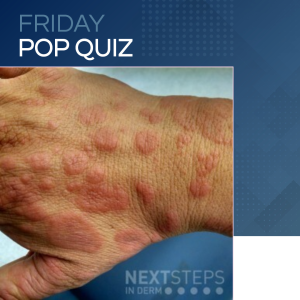
The correct answer is A. Erythema multiforme.
Erythema multiforme (EM) presents with target lesions favoring the extensor extremities.
Without a history, the examinee must discover distinguishing features in the clinical photo to arrive at the correct diagnosis. On the dorsal hand, there are variable edematous urticarial papules, some of which feature three zones: a dusky center surrounded by two concentric rings of different colors. Although not all of the lesions are fully developed, based on the presence of typical targets, EM (choice 1) is the best answer. The differential diagnosis includes annular urticaria (choice 2), which displays central erythema or normal skin, never epidermal damage as evidence by duskiness, necrosis, or vesiculation; secondary syphilis (choice 3), which tends to favor the palms over the dorsa and usually has scale; fixed drug eruption (choice 4), which can be morphologically similar to EM but generally shows fewer lesions; and polymorphous light eruption (choice 5), which also presents on the sun-exposed extremities and may at times be difficult to distinguish from EM, but will not have true targets. In clinical practice, additional history and possibly biopsy will readily differentiate between these entities.
References: Sokumbi O, Wetter DA. Clinical features, diagnosis, and treatment of erythema multiforme: a review for the practicing dermatologist. Int J Dermatol. 2012 Aug;51(8):889-902.
